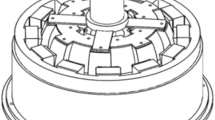Abstract
This paper presents a new analytical method for the computation of magnetic field distributions and electromagnetic performances in switched reluctance machines (SRM). The proposed model is sufficiently general to be used with any number of stator slots and rotor poles with electrically excited. Due to the inherent nonlinear characteristics of SRM, the conventional analytic model has a limited accuracy which does not take into account the saturation. In order to calculate the accuracy and consider the local magnetic saturation on the stator and rotor teeth, the proposed method is based on the resolution of 2-D Laplace’s and Poisson’s equations in polar coordinates by the separation of variables technique. The solution region is divided into three types of regular subdomains, viz. air gap, stator slots and rotor slots. Magnetic field distributions, flux linkage, self-inductance, mutual inductance and static electromagnetic torque computed with the proposed analytical method are validated through finite-element method.












Similar content being viewed by others
References
Madhavan R, Fernandes BG (2013) Axial flux segmented SRM with a higher number of rotor segments for electric vehicles. IEEE Trans Energy Convers 28:203–213
Chiba A, Kiyota K, Hoshi N, Takemoto M, Ogasawara S (2015) Development of a rare-earth-free SR motor with high torque density for hybrid vehicles. IEEE Trans Energy Convers 30:175–182
Fahimi B, Emadi A, Sepe RB (2004) A switched reluctance machine-based starter/alternator for more electric cars. IEEE Trans Energy Convers 19:116–124
Cheng H, Chen H, Yang Z (2015) Design indicators and structure optimization of switched reluctance machine for electric vehicles. IET Elect Power Appl 9(4):319–331
Takeno M, Chiba A, Hoshi N, Ogasawara S, Takemoto M, Rahman MA (2012) Test results and torque improvement of the 50-kw switched reluctance motor designed for hybrid electric vehicles. IEEE Trans Ind Appl 48(4):1327–1334
Michon M, Calverley SD, Atallah K (2012) Operating strategies of switched reluctance machines for exhaust gas energy recovery systems. IEEE Trans Ind Appl 48(5):1478–1486
Li G, Ojeda J, Hlioui S, Hoang E, Lecrivain M, Gabsi M (2012) Modification in rotor pole geometry of mutually coupled switched reluctance machine for torque ripple mitigating. IEEE Trans Magn 48(6):2025–2034
Husain I (2002) Minimization of torque ripple in SRM drives. IEEE Trans Ind Electron 49:28–39
Sahin C, Amac AE, Karacor M, Emadi A (2012) Reducing torque ripple of switched reluctance machines by relocation of rotor moulding clinches. IET Elect Power Appl 6(9):753–760
Vandana R, Fernandes BG (2015) Design methodology for high-performance segmented rotor switched reluctance motors. IEEE Trans Energy Convers 30(1):11–21
Zhu ZQ, Lee B, Huang L, Chu W (2017) Contribution of current harmonics to average torque and torque ripple in switched reluctance machines. IEEE Trans Magn 53(3):1–9
Dowlatshahi M, Nejad SMS, Ahn JW (2013) Torque ripple minimization of switched reluctance motor using modified torque sharing function. In: Proc. IEEE Iranian Conf. Elect. Eng., Mashhad, Iran, pp 1–6
Cao X, Zhou JX, Liu CY, Deng ZQ (2017) Advanced control method for single-winding bearingless switched reluctance motor to reduce torque ripple and radial displacement. IEEE Trans Energy Convers 32(4):1533–1543
Fu J, Zhu C (2012) Subdomain model for predicting magnetic field in slotted surface mounted permanent-magnet machines with rotor eccentricity. IEEE Trans Magn 48(5):1906–1917
Alam FR, Abbaszadeh K (2016) Magnetic field analysis in eccentric surface-mounted permanent-magnet motors using an improved conformal mapping method. IEEE Trans Energy Convers 31(1):333–334
Qian H, Guo H, Wu ZY, Ding XF (2014) Analytical solution for cogging torque in surface-mounted permanent-magnet motors with magnet imperfections and rotor eccentricity. IEEE Trans Magn 50(8):1–15
Pina AJ, Subhra P, Rakib I, Xu LY (2015) Effect of manufacturing variations on cogging torque in surface-mounted permanent magnet motors. In: 2015 IEEE Energy Conversion Congress and Exposition (ECCE), pp 4843–4850
Qiu ZJ, Dai J, Yang J, Zhou XY, Zhang YJ (2015) Research on rotor eccentricity compensation control for bearing less surface-mounted permanent-magnet motors based on an exact analytical method. IEEE Trans Magn 51(11):1–4
Radun A (1999) Analytical calculation of the switched reluctance motor’s unaligned inductance. IEEE Trans Magn 35(6):4473–4481
Khedda ZD, Boughrara K, Dubas F, Ibtiouen R (2017) Nonlinear analytical prediction of magnetic field and electromagnetic performances in switched reluctance machines. IEEE Trans Magn 53(7):8107311
Boughrara K, Lubin T, Ibtiouen R (2013) General subdomain model for predicting magnetic field in internal and external rotor multiphase flux-switching machines topologies. IEEE Trans Magn 49(10):5310–5325
Acknowledgements
This work was supported by National Natural Science Foundation of China (Project No. 51707072) and Applied Basic Research Project of Yichang (Project No. A19-402-a03).
Author information
Authors and Affiliations
Corresponding author
Additional information
Publisher's Note
Springer Nature remains neutral with regard to jurisdictional claims in published maps and institutional affiliations.
Rights and permissions
About this article
Cite this article
Jing, L., Cheng, J. & Ben, T. Analytical Method for Magnetic Field and Electromagnetic Performances in Switched Reluctance Machines. J. Electr. Eng. Technol. 14, 1625–1635 (2019). https://doi.org/10.1007/s42835-019-00167-0
Received:
Revised:
Accepted:
Published:
Issue Date:
DOI: https://doi.org/10.1007/s42835-019-00167-0




